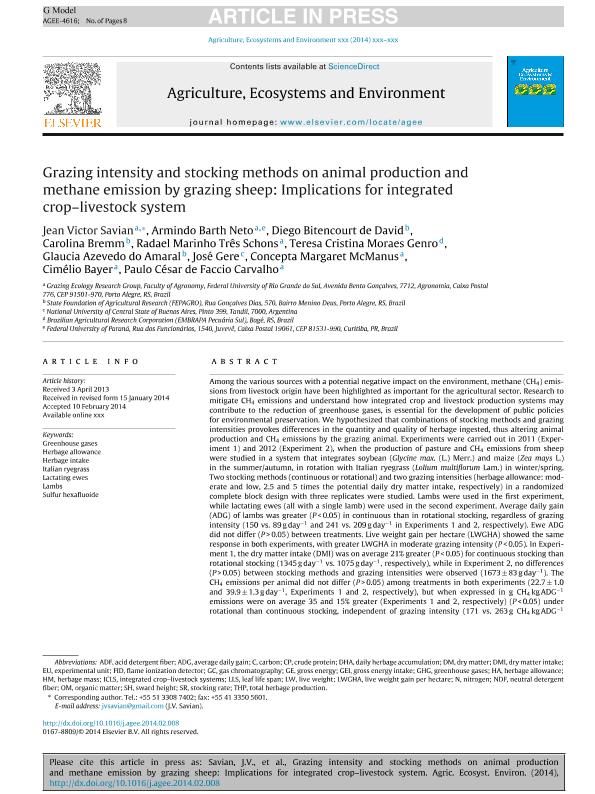Artículo
Grazing intensity and stocking methods on animal production and methane emission by grazing sheep: Implications for integrated crop livestock system
Savian, Jean Victor; Barth Neto, Armindo; Bitencourt de David, Diego; Bremm, Carolina; Marinho Três Schons, Radael; Moraes Genro, Teresa Cristina; Amaral, Glaucia Azevedo do; Gere, José Ignacio ; McMagnus, Concepta Margaret; Bayer, Cimélio; Faccio Carvalho, Paulo César de
; McMagnus, Concepta Margaret; Bayer, Cimélio; Faccio Carvalho, Paulo César de
 ; McMagnus, Concepta Margaret; Bayer, Cimélio; Faccio Carvalho, Paulo César de
; McMagnus, Concepta Margaret; Bayer, Cimélio; Faccio Carvalho, Paulo César de
Fecha de publicación:
03/2014
Editorial:
Elsevier
Revista:
Agriculture, Ecosystems and Environment
ISSN:
0167-8809
Idioma:
Inglés
Tipo de recurso:
Artículo publicado
Clasificación temática:
Resumen
Among the various sources with a potential negative impact on the environment, methane (CH4) emissions from livestock origin have been highlighted as important for the agricultural sector. Research to mitigate CH4 emissions and understand how integrated crop and livestock production systems may contribute to the reduction of greenhouse gases, is essential for the development of public policies for environmental preservation. We hypothesized that combinations of stocking methods and grazing intensities provokes differences in the quantity and quality of herbage ingested, thus altering animal production and CH4 emissions by the grazing animal. Experiments were carried out in 2011 (Experiment 1) and 2012 (Experiment 2), when the production of pasture and CH4 emissions from sheep were studied in a system that integrates soybean (Glycine max. (L.) Merr.) and maize (Zea mays L.) in the summer/autumn, in rotation with Italian ryegrass (Lolium multiflorum Lam.) in winter/spring. Two stocking methods (continuous or rotational) and two grazing intensities (herbage allowance: moderate and low, 2.5 and 5 times the potential daily dry matter intake, respectively) in a randomized complete block design with three replicates were studied. Lambs were used in the first experiment, while lactating ewes (all with a single lamb) were used in the second experiment. Average daily gain (ADG) of lambs was greater (P < 0.05) in continuous than in rotational stocking, regardless of grazing intensity (150 vs. 89 g day−1 and 241 vs. 209 g day−1 in Experiments 1 and 2, respectively). Ewe ADG did not differ (P > 0.05) between treatments. Live weight gain per hectare (LWGHA) showed the same response in both experiments, with greater LWGHA in moderate grazing intensity (P < 0.05). In Experiment 1, the dry matter intake (DMI) was on average 21% greater (P < 0.05) for continuous stocking than rotational stocking (1345 g day−1 vs. 1075 g day−1, respectively), while in Experiment 2, no differences (P > 0.05) between stocking methods and grazing intensities were observed (1673 ± 83 g day−1). The CH4 emissions per animal did not differ (P > 0.05) among treatments in both experiments (22.7 ± 1.0 and 39.9 ± 1.3 g day−1, Experiments 1 and 2, respectively), but when expressed in g CH4 kg ADG−1 emissions were on average 35 and 15% greater (Experiments 1 and 2, respectively) (P < 0.05) under rotational than continuous stocking, independent of grazing intensity (171 vs. 263 g CH4 kg ADG−1 and 171 vs. 202 g CH4 kg ADG−1 in Experiments 1 and 2, respectively). Stocking method was more important than grazing intensity in determining methane production by grazing sheep. Continuous stocking was the most efficient grazing management in reducing methane emissions per unit animal production.
Archivos asociados
Licencia
Identificadores
Colecciones
Articulos(SEDE CENTRAL)
Articulos de SEDE CENTRAL
Articulos de SEDE CENTRAL
Citación
Bitencourt de David, Diego; Marinho Três Schons, Radael; Barth Neto, Armindo; Bremm, Carolina; Faccio Carvalho, Paulo César de; Bayer, Cimélio; et al.; Grazing intensity and stocking methods on animal production and methane emission by grazing sheep: Implications for integrated crop livestock system; Elsevier; Agriculture, Ecosystems and Environment; 190; 3-2014; 112-119
Compartir
Altmétricas



